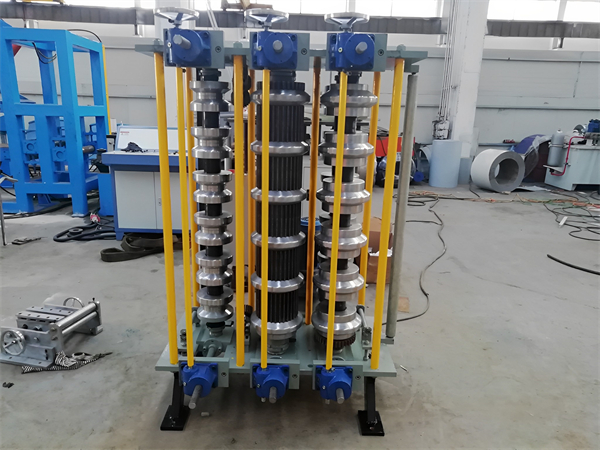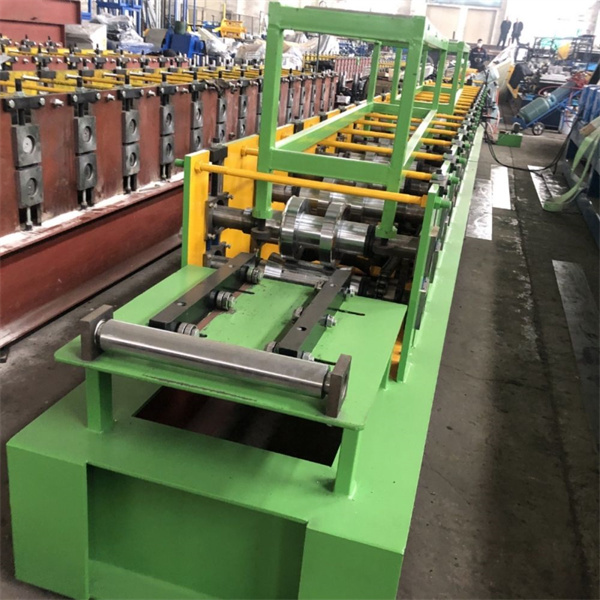C profile roll forming machines are used to continuously bend and form metal coils into C shaped profiles. These versatile machines are widely utilized to manufacture structural steel frames, wall panels, roofing, racking systems, solar panel frames and more. This comprehensive guide provides a detailed overview of C profile roll forming equipment, their working principles, main components, specifications, applications, advantages, and tips for selecting suppliers.
Overview of C Profile Roll Forming Machines
C profile roll forming machines take flat metal strips, bend them gradually into a ‘C’ shaped cross-section using a series of rotating rollers. The forming stations apply incremental bends along the strip to shape it into the desired profile.
These machines offer continuous, high-speed, and automated production of C profiles in various sizes and gauges. Key benefits include flexible production, reduced labor, quality output, and lower costs compared to other forming methods.
Types of C Profile Roll Forming Machines
| Type | Description |
|---|---|
| Vertical C Profile Machine | Rollers arranged in vertical position, takes horizontal path |
| Horizontal C Profile Machine | Roller stations laid horizontally, strip moves vertically |
| Combined C&U Profile Machine | Can produce both C and U profiles |
| Customized C Profile Machine | Tailor-made for specific profile dimensions |
Main Components of a C Profile Roll Forming Machine
C profile roll forming machines consist of uncoiler, feeding unit, main rolling section, cutting unit, and other components outlined below:
- Uncoiler: Releases required length of coil material
- Feeding Unit: Feeds strip into forming sections at set speed
- Forming Stations: Bend strip incrementally to shape C profile
- GuidingRoller Units: Support and guide strip during forming
- Cutting Unit: Cuts profiles to specified length
- Haul-off Unit: Pulls formed profiles out of the machine
- Control Panel: Controls machine settings and operations
- Frame: Provides robust structural foundation for components
Specifications of C Profile Roll Forming Machines
| Specifications | Typical Values |
|---|---|
| Forming Speed | 10 – 25 m/min |
| Max Coil Width | Up to 1250 mm |
| Min Coil Width | 150 mm |
| Material Thickness | 0.3 – 2 mm |
| Max Profile Height | 400 mm |
| Roller Diameter | Φ100 – Φ220 mm |
| Power Consumption | 22 – 110 kW |
| Voltage | 380V/415V/480V, 50/60Hz, 3 Phase |
Applications and Uses of C Profile Roll Forming
C profile roll forming machines have a wide range of applications due to the versatile C shape:
- Structural frames for buildings, sheds, greenhouses
- Wall panels, cladding, partition systems
- Roofing sheets, solar panel frames
- Racking, shelving, storage systems
- Scaffolding, safety barriers, handrails
- Agricultural, transportation, mechanical uses
- Furniture frames, signage, billboards

How to Choose a C Profile Roll Forming Machine
Selecting an appropriate C profile roll forming machine requires evaluating key factors:
Type of C Profile
- Dimension and thickness of profile
- Complexity of shape – simple or variable bends
- Single or combined profiles
Production Output Needs
- Output volume per hour/shift
- Line speed required
Material Specifications
- Metal type – steel, aluminum, others
- Coil width, thickness, specs
Space Constraints
- Overall footprint area
- Layout restrictions
Control and Automation Needs
- Level of automation, precision, efficiencies needed
- Software and control capabilities
Budget Constraints
- Purchasing costs affordability
- Operating and maintenance costs
Supplier Capabilities and Services
- Customization flexibility
- Quality standards
- Installation, training, support services
Comparing C Profile Roll Forming Machine Brands
| Brand | Equipment Range | Max Speed | Automation Options | Key Strengths |
|---|---|---|---|---|
| Metform | Wide portfolio | High speed | Full automation available | High precision, reliability |
| Jinan FF | Diverse customization | Up to 25 m/min | Semi or full automation | Cost effective solutions |
| Zhongyuan | Standard & custom | 20 m/min | Semi-automatic models | Robust designs for heavy duty use |
| SharpeRollmac | Standard range | Up to 15 m/min | Semi-automatic | Simple operation, affordable pricing |
| DIWAL UK | Custom machines | Up to 20 m/min | Automation modules available | Top quality European engineering |
When comparing brands for C profile roll forming equipment, key factors to consider are the product range, maximum line speeds, automation features, production quality, customization flexibility, prices, and services offered. Leading global brands have expertise in delivering high-performance and reliable machines tailored to customer requirements.
Typical Pricing for C Profile Roll Forming Machines
C profile roll forming machine prices vary based on:
- Production Speed – Higher speeds increase machine cost
- Automation – Fully automatic models are more expensive
- Size and Capacity – Larger profiles and coils cost more
- Material Type – Stainless steel and aluminum lines are costlier
- Customization – Tailor-made machines are pricier
| Speed | Semi-Auto Price Range | Fully-Auto Price Range |
|---|---|---|
| 10 m/min | $30,000 – $60,000 | $80,000 – $120,000 |
| 15 m/min | $50,000 – $90,000 | $130,000 – $180,000 |
| 20+ m/min | $70,000 – $150,000 | $200,000 – $300,000 |
Contact manufacturers directly for latest pricing based on your specifications.
How to Operate and Maintain C Profile Roll Forming Machines
Proper operation and maintenance are key for maximizing productivity and longevity of C profile roll forming equipment.
Operation Guidelines
- Carefully thread coil through equipment
- Set appropriate line speed, monitor strip flow
- Ensure rollers apply even pressure along forming stations
- Check profiles for defects and adjust settings
- Utilize control panel to adjust parameters
- Implement safety procedures for running machinery
Maintenance Tips
- Lubricate moving parts per schedule
- Inspect rollers and bearings, replace if worn
- Check electrical, hydraulic, and pneumatic systems
- Verify forming stations are aligned and gap-free
- Clean equipment and work area regularly
- Tighten any loose bolts, fittings, connections
- Keep records of maintenance activities
Follow manufacturer’s instructions for safe operation, troubleshooting, and preventive maintenance. Investing in regular upkeep results in higher performance and longevity of C profile roll forming machines.
Installing C Profile Roll Forming Equipment
Proper installation is crucial for smooth functioning of C profile roll forming lines. Here are key guidelines:
- Prepare suitable foundation and flooring able to withstand machine weight and vibration
- Ensure adequate space for safe operation around equipment
- Lifting and positioning machines requires overhead crane and qualified riggers
- Bolt down machine securely following manufacturer’s instructions
- Level and align machine properly, shim if required
- Connect electric, pneumatic, lubrication lines per specs
- Install safety guards around moving parts
- Test run machine empty first to verify smooth operation
- Initiate production at low speeds first, then gradually increase
- Train staff thoroughly on safe working procedures
Work closely with your roll forming machine supplier to plan transportation, site readiness, and professional installation for optimal performance.
Choosing a Roll Forming Machine Manufacturer
Selecting the right roll forming machine supplier is key to getting equipment that meets your production needs and budget.
Key Criteria for Supplier Selection
- Years of experience with proven track record
- Wide range of standard and custom machines
- Capability to engineer solutions for your requirements
- High quality manufacturing with strict tolerances
- Responsiveness to technical queries
- Professional installation and operator training
- Maintenance support and service capability
- Competitive pricing and timely delivery
- Willingness to modify designs if needed
- Strong references from existing customers
Best Practices for Purchasing
- Provide detailed specifications for your application requirements
- Ask for design drawings and machine details for review
- Clearly agree on pricing, delivery schedule, payment terms
- Ensure on-site support for installation & training
- Check credentials, clientele, review sample work
- Inspect machine quality upon delivery before payment
- Request trial runs to validate performance
Choosing the right manufacturing partner helps avoid many issues and ensures you get high-performing roll form equipment tailored for your needs. Rank suppliers based on capability fit, get quotes from the shortlisted vendors, and make an informed purchasing decision.

Advantages and Benefits of C Profile Roll Forming
Key benefits of using C profile roll forming machines:
High Production Volumes
- Continuous operation allows very high output
- C profiles produced at fast rates up to 25 m/min
- Automated lines provide 24/7 operating capability
Material and Energy Efficiency
- Consistent quality with minimal material wastage
- No heating or cooling needed compared to bending
- Lower power consumption than other methods
Labor Cost Savings
- Automated forming reduces labor required
- Less manual handling compared to other techniques
- Lower overhead costs
Flexibility
- Quick roll changes for different profiles
- Wide range of material thickness and sizes
- Adjustments possible for small batch production
Superior Product Quality
- Consistent and precise dimensions
- Excellent surface finish free of flaws
- Fine tolerances maintained along the profile
- Repeatability for large production volumes
Limitations of C Profile Roll Forming
Roll forming does have some inherent limitations:
Profile Limitations
- Mostly limited to constant cross-section profiles
- Size constraints based on machine capacity
- Difficult to form very complex or combined shapes
Initial Tooling Costs
- Roll sets need to be custom made for new profiles
- Design and production of roll tools involves costs
Line Changeover
- Changing between different profiles requires roll change
- Production planning needed to optimize changeovers
Material Considerations
- Limited to softer materials like mild carbon steel
- Not ideal for hard metals or exotic alloys
Part Length Limits
- Maximum blanking length restricted by machine length
- Additional operations needed for longer parts

FAQ
Q: What metals can be roll formed into C profiles?
A: Commonly roll formed metals include mild steel, stainless steel, and aluminum. Other materials like copper, brass can also be formed in some cases.
Q: What industries use C profile roll forming machines?
A: Major applications are in building construction, warehouses, solar farms, material handling, transportation, agriculture, automotive sectors.
Q: Can I get customized C profiles made?
A: Yes, custom C profile dimensions are possible by designing profile-specific roll tooling. Provide detailed drawings to your roll forming equipment supplier.
Q: How long do C profile roll forming machines last?
A: With proper maintenance and operation, lifespan of 15-20 years is common. Ensure regular upkeep for maximum longevity.
Q: What safety measures are required?
A: Safety guards, emergency stops, proper machine operation training, protective gear for operators, and safe working protocols are essential.
Q: What factors affect the price of C profile machines?
A: Key factors are profile size, production speed, automation level, material type, production volumes, and customization needs.
Q: Can one machine make both C and U profiles?
A: Yes, some adjustable or multi-profile roll forming machines can be configured with tooling to produce both profiles.
Q: Should I buy new or used C profile equipment?
A: For critical production needs, new machines are recommended for reliability. Used equipment can work for semi-manual shops on a tight budget.
Q: How much space is needed to install a C profile line?
A: Typically allow at least 5-6 meters in length, 2-3 meters in width for safe operation. Larger and faster lines require more space.
